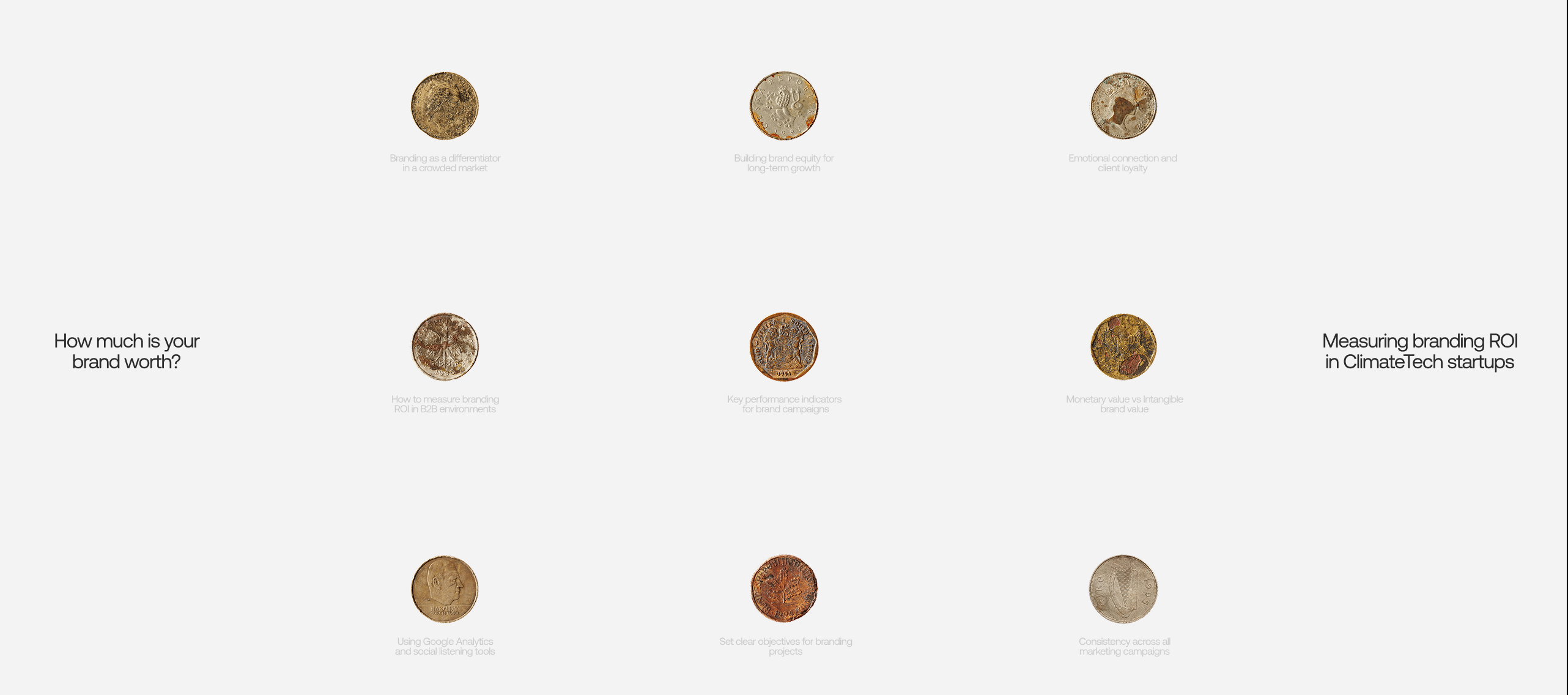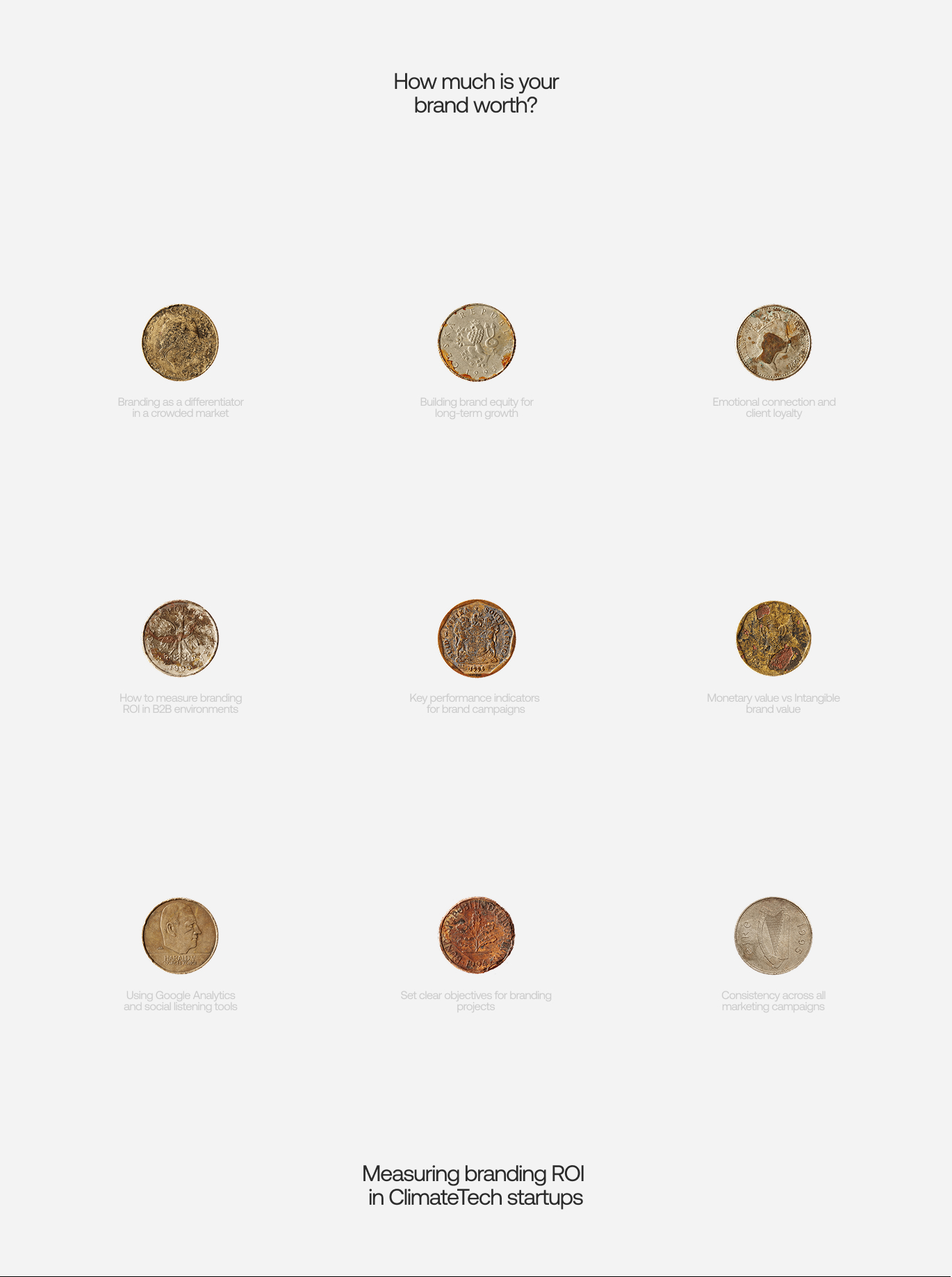

How much is your brand worth? Measuring branding ROI in ClimateTech startups
Branding
28/7/2025
For climate tech B2B startups, brand building often takes a backseat to product development, fundraising, or go-to-market efforts. But overlooking branding can quietly drain resources and limit growth.
A strong brand creates real, measurable business value. From attracting better leads to improving retention and supporting higher pricing, branding is a strategic asset with serious ROI.
This article dives into what the numbers say about the ROI of branding for climate tech startups, offering a data-driven look at how and why investing in brand equity early can lead to long-term gains.
1. Why branding powers ClimateTech growth
Branding as a differentiator in a crowded market
ClimateTech startups face stiff competition from both established players and emerging innovators. With increasing investment in the sector, many businesses are offering similar-sounding solutions. This saturation makes it difficult for buyers to differentiate between options, unless a brand stands out.
A strong brand cuts through the noise:
• It communicates unique value propositions clearly.
• It positions your company as trustworthy and professional.
• It builds immediate recognition in a fast-moving industry.
According to Pangolin Marketing, brand identity plays a central role in how climate tech companies are perceived by both clients and investors.
Building brand equity for long-term growth
Brand equity, the perceived value and strength of a brand, directly impacts business growth. It influences:
• Repeat purchases from loyal clients
• Word of mouth recommendations
• User lifetime value increases
A clear and compelling brand strategy helps climate tech startups secure better partnerships, attract top talent, and generate more leads throughout the sales cycle.
Emotional connection and client loyalty
Beyond the technical specs, buyers want to feel aligned with a company’s mission and values. Branding helps build that emotional connection. When clients connect with your brand story, they are more likely to:
• Engage regularly with your content
• Recommend your product to peers
• Stick with your company for the long haul
This emotional alignment fosters brand loyalty and creates a deeper client base that goes beyond transactional relationships.
2. The metrics behind branding ROI in ClimateTech startups
How to measure branding ROI in B2B environments
While branding can feel intangible, there are multiple ways to measure branding ROI using both direct and indirect metrics:
• Increased brand awareness and recognition
• Growth in website traffic and direct traffic
• Higher conversion rates from marketing campaigns
• Improved sales figures and market share
The challenge lies in attributing the monetary value of brand perception but it's not impossible with the right tracking and benchmarks.
Key performance indicators for brand campaigns
Direct traffic and website traffic increases
If more people are typing your URL directly or searching your brand name, that’s a clear sign of increased brand awareness. Tools like Google Analytics help measure this effectively.
Brand recognition and awareness benchmarks
You can track brand recognition over time using:
• Brand surveys
• Social listening tools
• Organic search volume for branded terms
Net promoter scores and word of mouth
High NPS scores and client referrals indicate strong brand reputation. This often correlates with:
• High client satisfaction
• Greater brand equity
• More repeat users
Monetary value vs Intangible brand value
How much value does your brand contribute to overall business success? It can be seen in:
• Higher price tolerance by clients
• Faster sales cycles
• Less discounting required by your sales team
While harder to quantify, these factors represent tangible benefits over time.
Using Google Analytics and social listening tools
Pairing tools like Google Analytics, HubSpot, and Brandwatch can help you:
• Track direct and organic traffic trends
• Monitor client engagement with branded content
• Listen to client perceptions and keyword sentiment
3. Best practices for maximising branding ROI
Set clear objectives for branding projects
Start with specific goals: Is it to increase visibility, drive sales, or improve perception?
Clear goals help you track progress and adjust branding efforts accordingly.
Consistency across all marketing campaigns
A consistent visual identity and brand messaging across all channels ensures a unified experience. This consistency leads to:
• Stronger recall
• Improved client trust
• Better overall brand performance
Partnering with a specialised branding agency
ClimateTech startups often benefit from working with a branding agency that understands the nuances of sustainability and tech. An expert partner can:
• Refine your brand strategy
• Develop a compelling brand story
• Guide early branding campaigns
Invest in visual appeal and brand storytelling
Your logo, typography, and imagery are the first impressions that your brand makes. But the real power lies in telling a compelling brand story that resonates with your target audience.
• Showcase mission-driven innovation
• Highlight real client outcomes
• Reinforce your vision for climate impact
Benchmark brand KPIs and track progress
Use key performance indicators like:
• Direct traffic increases
• Social media engagement
• Growth in repeat purchase rates
These indicators help you evaluate the true value and effectiveness of branding efforts.
4. How branding converts more B2B leads
Brand messaging that aligns with client journey
Branding guides prospects through every stage of the user journey:
• Awareness: Clear mission and value prop
• Consideration: Case studies and proof of impact
• Decision: Trust signals and expert positioning
Creating a lasting impression to drive engagement
From landing pages to email signatures, every branding touchpoint matters. High-quality, consistent branding helps:
• Improve lead quality
• Increase engagement rates
• Reduce bounce rates on websites
Case studies: Branding-driven increases in sales figures
Startups that invest in branding early often enjoy measurable business benefits. Take AIRCO, a sustainable aviation fuel startup, as a notable example:

• What they did: Originally branded as a consumer lifestyle brand (“AIR Vodka”), AIRCO repositioned itself to focus on its core mission, providing industrial-scale climate tech solutions. This included a comprehensive website overhaul, an updated brand identity, and a targeted campaign aimed at commercial and industrial partners.
• The result: Following the rebrand, AIRCO saw a marked increase in inbound commercial inquiries and pilot project leads. Their revamped identity “bridges the past and the future, ensuring that the company’s identity matches its groundbreaking ambitions.”
While the specific percentage gain in inbound leads wasn't disclosed publicly, the case highlights a clear shift: stronger brand resonance with industry buyers led to a surge in qualified, sales-ready conversations illustrating how strategic branding in climate tech can drive real B2B growth.
The role of brand strategy in generating more revenue
Your brand influences pricing power, sales confidence, and client perception. A well-executed brand strategy makes your company appear more established, even in the early stages, which boosts client lifetime value and more revenue opportunities.
5. The hidden cost of delaying branding
Lost market share and missed opportunities
Startups that delay branding often find themselves overlooked, even if they possess innovative technology. In B2B climate tech, perception is everything. A weak or unclear brand can lead to:
• Lost market share to competitors with stronger positioning
• Inability to attract early adopters or strategic partners
• Missed press and investor attention
Impact on client perception and brand reputation
Without a coherent brand, client perceptions can become fragmented or negative. Inconsistencies in messaging, design, or voice confuse potential clients and erode trust.
• Lack of brand clarity = lower brand reputation
• Unclear messaging = lost opportunities to convert leads
Cost savings over time from a strong brand foundation
Investing in branding early may seem costly, but it’s a cost-effective strategy over the long term:
• Less time spent explaining your value
• Reduced reliance on paid ads due to word of mouth recommendations
• Fewer costly pivots or rebrands down the line
Hiring top talent and increasing company value
A recognisable and mission-driven brand attracts not just clients, but also top talent. High-growth climate tech startups with great brand reputations:
• Hire faster
• Retain talent longer
• Increase overall company valuation
6. FAQs: Branding ROI for ClimateTech startups
What is a good ROI for branding in a startup?
There’s no fixed number, but positive ROI often looks like:
• Increased lead volume and conversion rates
• Reduced client acquisition costs
• Improved repeat purchase rates
How can branding drive repeat purchases?
A strong brand builds emotional trust and reinforces your value. Clients who trust a brand are more likely to come back, especially in B2B environments where repeat business is vital.
Is branding cost-effective for early-stage companies?
Yes, branding helps early-stage companies create a lasting impression, reduce churn, and stand out. It’s a high-leverage investment that supports every part of the user journey.
What are the most important brand KPIs to track?
Some key brand KPIs include:
• Direct traffic
• Brand search volume
• Client retention
• Net promoter score (NPS)
• Engagement with branded content
How long does it take to see ROI from branding efforts?
Most companies begin to see branding impact within 6 to 12 months, especially if integrated with marketing and sales activities. Long-term ROI grows exponentially as brand equity increases.
Can branding help reduce client acquisition costs?
Absolutely. A strong brand creates brand recognition, reduces reliance on paid ads, and shortens the decision-making process, all of which contribute to cost savings.
Conclusion: Branding is a long-term growth engine
For ClimateTech B2B startups, branding is a growth multiplier. It fuels everything from client acquisition to retention, boosts your ability to attract talent and investment, and creates a foundation for long-term success.
The data shows that branding delivers both tangible benefits and intangible equity, making it one of the smartest early investments a startup can make. Whether you are tracking brand KPIs like website traffic or focusing on user loyalty, the evidence is clear: branding pays off.
Start early, invest smartly, and align your branding efforts with measurable goals. The result? A resilient company built to thrive, not just survive, in the climate tech space.
Recent Articles
content on
-min.png)



.svg)

